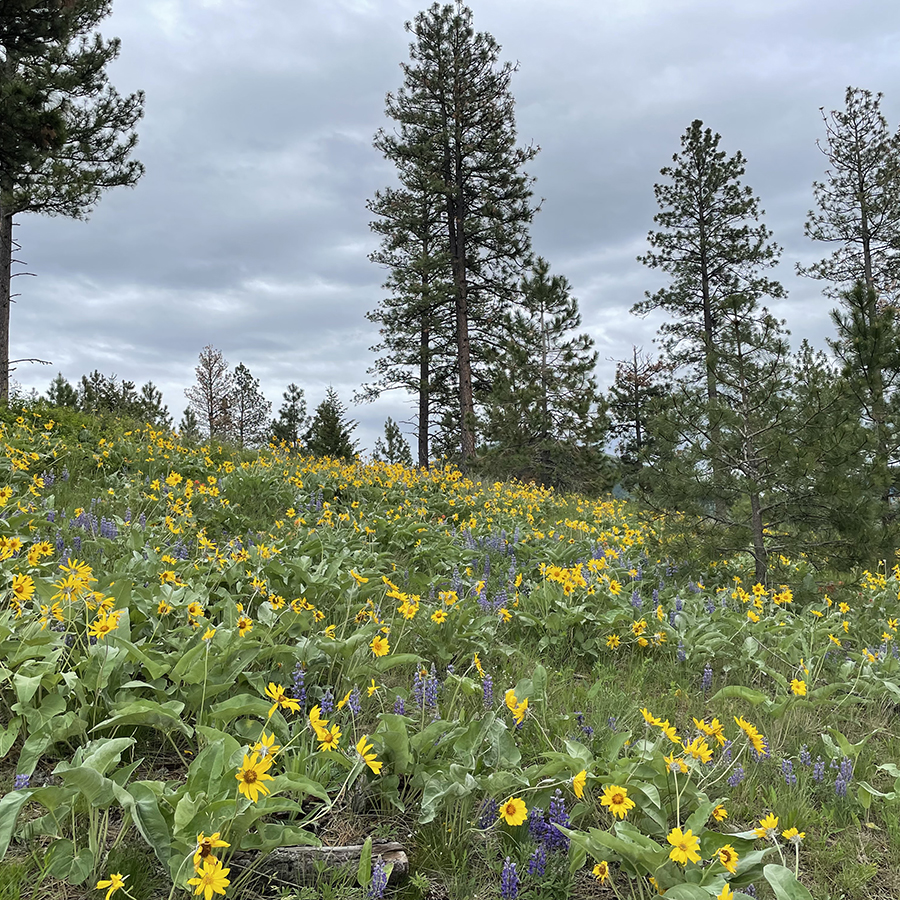Research
Physiological Plant Ecology
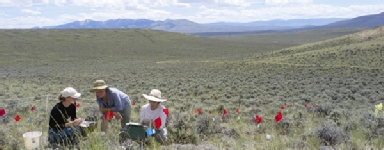
Research Areas
Carbon Dynamics in Trees
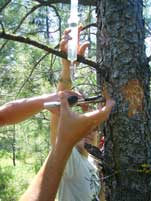
About 45% of plant biomass is carbon. Clearly, plants need a lot of carbon not only to build their tissues but also for other functions including fuel for respiration. Not surprisingly, perennial plants store non-structural carbon compounds (NSCC, compounds not permanently locked into cell walls and other structures) which are thought to serve as a reservoir when stressful conditions prevent carbon supply to meet demand (e.g. herbivory or drought). What is surprising is that stored NSCC pools are generally abundant and often not used as expected under stressful conditions.
- Do abundant stored non-structural carbon pools in plants mean that plants assimilate carbon in excess of what they need?
- Is storage on non-structural carbon compounds simply a reservoir of carbon, or does it serve other critical functions, including an osmotic function to retain and move water?
We (with many collaborators within and outside the University of Montana) are using several approaches to address these questions, ranging from literature reviews to greenhouse experiments (one with Aurora Bayless, an undergraduate student).
Costs of fast growth in trees
Life history theory predicts that organisms cannot maximize all fitness-enhancing functions simultaneously and that tradeoffs (e.g. growth-mortality, growth-defense) often arise.
- Do inherently slow growing trees live to older ages? If so, what are the possible mechanisms?
- Does breeding for fast growth come at the cost of reduced insect and drought resistance?
We have/are addressing these questions from comparisons of old (>350 years old) and young (<200 years) trees co-occurring in the same stand in nature and comparing their growth rates and potential traits that may increase survival (wood density and anatomy). This was the dissertation of Erik Keeling (now a faculty at New Paltz) and a senior thesis by Beth Roskilly (now a graduate student in the Sala lab). We are also using genetic trials where growth and survival have been measured over time, including after a recent mountain pine beetle attack (with Raúl de la Mata, a post doc, who moved to another post doc at the University of Alberta and Sharon Hood, now a scientist at the Forest Service).
Bark Beetles
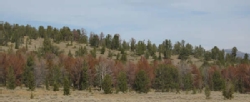
Mountain pine beetle outbreaks have caused extensive mortality across western North American pine forests. A first line of defense against beetles is resin produced by resin ducts, which, if sufficient, pitches out entering beetles. During outbreaks, however, resin defenses are usually overwhelmed by mass attacks. Beetles then enter the host tree and spread associated fungi which grow into the phloem and sapwood. Beetles mate and lay eggs under the bark where larvae develop by feeding from the phloem and the fungi in it.
- Do beetle-associated fungi benefit beetles by tapping into the sapwood and accessing a resource pool not available to the beetles? Does this depend on the host? (note that the sapwood in nutritionally poor relative to the phloem, but it is of much larger volume and holds a larger pool of stored nutrients).
- Does low severity, frequent fire stimulate resin production and resin flow? If so, has fire exclusion relaxed pine defenses against bark beetles?
- Is there a tradeoff between growth rate and resin defenses?
These questions have or are being addressed by several graduate students: Nora Lahr (now a post doc at Texas), Sharon Hood (now a Scientist at the Forest Service) and Sean Pinnell (MS student), and by a recent post doc (Raúl de la Mata, now a post doc at the University of Alberta). We have used field work in natural stands as well as genetic trials.
Tree Death
Issuing a death certificate in trees is a very tricky job because a long time (often years) can go by from the point a tree irreversibly enters the death row to the point when there is no doubt it is dead.
- What endogenous (e.g. physiological states) and/or exogenous (e.g. environmental) factors cause trees to irreversibly enter the death row?
We are/will address this question from greenhouse and field studies. We (with Solomon Dobrowski, Marco Maneta and others) have recently received NSF funding to address this question in seedlings. Gerard Sapés is doing his PhD on this. I am also collaborating with folks at CREAF, Barcelona, Spain.
Fire Regimes and Tree Physiology
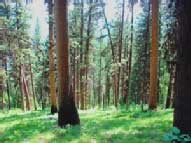
Fire regimes in many fire-dependent forests of the US have changed substantially due to the active suppression of fires since the early 1900. As a result some forests are now much different than they were under their natural fire regimes.
- What are the consequences of alteration of fire regimes on resource availability and tree performance, including defenses against pests?
- Can management reverse the negative effects of altered fire regimes on trees?
This work has spanned several years and involved several colleagues and graduate students, including Greg Peters (now a faculty at the Missoula College), Derek McKenzie (faculty at the University of Alberta), Eric Keeling (now at New Paltz University), Sharon Hood (now a Scientist at the Forest Service). We have used field sites subjected to natural fire regimes, as well as sites subjected to active management/restoration.
Old Trees
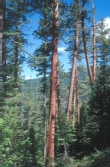
Old trees are phenomenal. They have survived for centuries or millennia in the precise spot where they germinated without the ability to run for food or shelter.
- What traits contribute to the extraordinary resilience of old trees?
This project emerged from the dissertation of Eric Keeling (now a faculty at New Paltz University). Beth Roskilly (now a graduate student in my lab) evaluated potential mechanisms for her senior thesis by studying wood anatomy.
Ecophysiology of Conifers
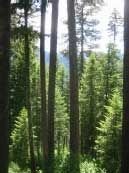
Some conifer species in the interior Rocky Mountains hold a relatively large proportion of foliage relative to others. Yet, in spite of consequences on water use and resistance to drought, they may all co-occur in similarly dry sites suggesting that the variability in hydraulic traits is associated with species-specific biomass allocation patterns and physiology.
- How variable are hydraulic traits among conifer species?
- What are the consequences of changes in resource availability (due to pests, pathogens and disturbance) on tree physiology, biomass allocation and growth?
This work has also spanned several years and involved many colleagues as well as graduate and undergraduate students.
Masting
In some plant populations flowering does not occur every year and when it occurs it is synchronous among individuals (masting).
- What are the physiological mechanisms underlying the episodic and synchronous reproductive events (masting) in plant populations?
This NSF funded project was a collaboration with Elizabeth Crone (now at Tufts University) and involved several undergraduate students, including Kelly Hopping (now a post doc at Stanford) and Beth Miller (finishing her PhD).
Prolonged Dormancy
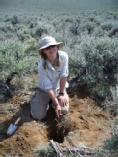
Some herbaceous, perennial plants show an intriguing life history strategy: they occasionally remain belowground and not come up for one or several years.
- What triggers some plants to stay below ground in a state of prolonged dormancy?
- Why do some plants skip a growing season and forego the opportunity to acquire resources and reproduce?
This was the dissertation of Jenny Gremer (now a faculty at UC Davis) and was a collaboration with Elizabeth Crone (now at Tufts University), who served as her co-advisor.
